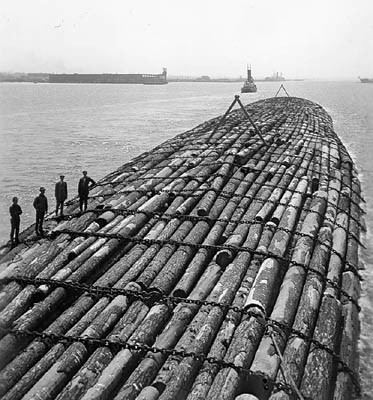 | ||
The Benson raft was a huge seagoing log raft designed to reliably transport millions of board feet of timber at one time through the open ocean.
Contents
Held together with giant logging chains, their cargo of logs and often finished lumber goods went from the outlet of the Columbia River in the United States into the Pacific Ocean and south 1100 miles to San Diego, California. Once there the logs were sawn into lumber by the Benson Logging and Lumber Company for sale in Southern California.
History
While this practical transportation method was first used on the Pacific coast in 1906 by Simon Benson, a lumber baron of Portland, Oregon, they were not the first rafts of their type. Some appeared on the Atlantic coast about 1883 and were used for several years until a very large one broke up and became a hazard to navigation. They were sometimes referred to as Leary rafts or Joggins rafts. They seem also to have been employed on the Rhine River in 1888, and their use on the Pacific was contemplated as early as 1888.
Lower shipping costs
Benson log rafts were towed in the open sea along the Pacific Coast, dramatically lowering shipping costs from railroad or traditional ocean barge transportation. Held together by large logging chains, they were the first ever seagoing ocean-worthy logging rafts to transport intact millions of board feet over a long distance. The first was launched in July 1906 and last of 120 in 1941. About half were "deck loaded", with processed lumber such as shingles, fence posts, and poles atop the logs, maximizing savings. Four of the 120 were lost due to fire or storms.
John A. Festabend was Benson's construction supervisor near Clatskanie, Oregon.
Construction
Benson rafts began with a roughly cigar-shaped temporary "cradle" of wood resembling the frame of a large wooden sailing ship. A derrick placed logs in the cradle over a period of four to seven weeks, lacing them with tree-length timbers for added strength and stability. Large logging chains tied the raft together.
When complete, one half of the cradle was removed and the raft was launched sideways into the water. Most were about 700 feet (210 m) to 1,000 feet (300 m) long, 55 feet (17 m) wide, and 35 feet (11 m) thick from top to bottom—usually drafting 26 feet (7.9 m) to 29 feet (8.8 m) deep and hauled between 4,000,000 board feet (9,400 m3) and 8,000,000 board feet (19,000 m3) of logs. Assembly took anywhere from 4 to 6 weeks and involved 175 to 250 tons of chain.
It is estimated that building in Southern California doubled in just 4 years following the arrival of cheaper lumber via Benson rafts in 1906.
A proposal was floated in 1905 to use them to ship timber to China, but there is no evidence it ever occurred.
